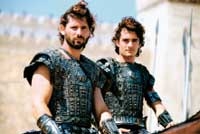Sony KDS-R60XBR1 60-inch SXRD HDTV Page 2
| The Short Form |
| $4,500 ($4,999 LIST) / 66 x 39.75 x 20.25 IN / 112 LBS / sonystyle.com / 877-865-SONY |
| Plus |
| •Deep blacks and detailed shadows •Fully resolves 1080i signals on HDMI |
| Minus |
•Slight rosy cast on bright fields •Stationary screen grain •Cannot accept 1080p sources  |
| Key Features |
| •1,920 x 1,080 pixel resolution SXRD (LCoS) 60-inch display •Digital cable-ready with CableCARD •Adjustable Iris •inputs 2 HDMI, 2 FireWire, 2 component-video inputs, 1 VGA input •Price $4,500 ($4,999 list) |
| Test Bench |
| My Sony KDS-R60XBR1 review sample's initial grayscale tracking came extremely close to the ideal of 6,500 K in the Pro picture setting, and only minor adjustment of the user-menu white-balance controls was required to bring it nearly dead-on. Resolution was excellent via HDMI, with the Sony displaying every line of a 1080i test pattern, but it couldn't do the same thing from its component-video input. Color decoding was extremely accurate. With the Iris set to Zero and Auto Iris engaged, I measured the deepest average black level yet at 0.06 footlamberts. Full Lab Results |
As Agamemnon and Nestor plan to invade Troy, for example, the shadowy alcoves toward the back of the room were dim yet carried discernible details: the faces of statues, craggy black stones in a burning brazier, and individual steps in the dais behind the king. The black horsehair of his brush appeared inky, and individual strands of hair were clearly visible as he dragged it across a map of Greece. The Sony had absolutely no trouble resolving all of the details in the film.
Skin tones are one of the best ways to judge the accuracy of colors, and the Sony delivered the goods in this skin-filled flick. The head of Hector's infant son ran from light apple on the cheeks to pale around the dribbling mouth. The face of Hector's stately wife was subtly colored and shaded in the morning light. Colors throughout the film were deeply saturated, from the blue of the Aegean Sea to the dark red, almost black blood from the nose of Achilles. Nor was there any hint of untoward gradations or "false contouring" - an obvious banding effect that frequently occurs when a set should be displaying the subtle transition between light and dark areas. During the shot of the Greek fleet sailing toward Troy, for example, the camera pulls back to reveal hundreds of ships arrayed all the way to the horizon, with clouds fading smoothly into the sea and no evidence of banding.
On the other hand, I did detect a very subtle purple or pink cast that was evident in the sky above Troy in the next scene, and occassionally saw the same effect in other scenes with large light-blue or white fields. And while scenes like this were clean and free of video noise, these flat fields also brought out the fine stationary grain present in the Sony's rear-projection screeen. Nearly every rear-projection HDTV shares this screen effect, though in this case it was more noticeable than on some recent sets I've tested. The picture also became dimmer and more noticably discolored when viewed from the extreme left or right at angles more than 45° or so off center.
An HDTV with 1080p resolution exercises only a fraction of its detail potential when displaying DVD, so I turned to another kind of war to see the rest: the AFC Championship game between Denver and Pittsburgh courtesy of CBS HD. The first thing I noticed was simply the grass on the field. Even in the widest shots, I could discern the close-cropped texture of the turf, detect patches of brown earth in the middle of the field, and see clods of dirt where cleats had torn at the sod. During slow-mo close-ups, I could see the mesh on Pittsburgh's white jerseys and tiny dirt clods arcing lazily across the screen. After the Steelers kicked an extra point, I even saw the fine grid of the net behind the uprights. Simply put, the Sony KDS-R60XBR1 looked as detailed as any HDTV I've ever seen.
Colors came alive under the afternoon sun, and crowd shots were dominated by a wash of brilliant Bronco orange. The green of the field was deep and lush instead of limey, and the sunburn on head coach Mike Shanahan's cheek was obvious. Significantly more subtle but certainly visible in some shots was the Sony's tendency to be brighter toward the middle of the screen and dimmer toward the corners. During a shot that followed Shanahan's walk along the sidelines, I noticed that the white wall behind the players looked a bit darker in the lower left corner of the screen than elsewhere. Again, the difference was very subtle (and limited to mostly flat fields), and this modest "hot-spotting" didn't detract from my enjoyment of the game.
BOTTOM LINE As impressed as I've been with the 1080p projection sets I've reviewed recently, the Sony KDS-R60XBR1 60-inch SXRD HDTV delivers a better picture overall than any of them. No, it's not perfect - and yes, it's still more expensive than most of its competition. But I think many buyers - from card-carrying video geeks to casual TV watchers - will agree it's worth the extra cash.








































